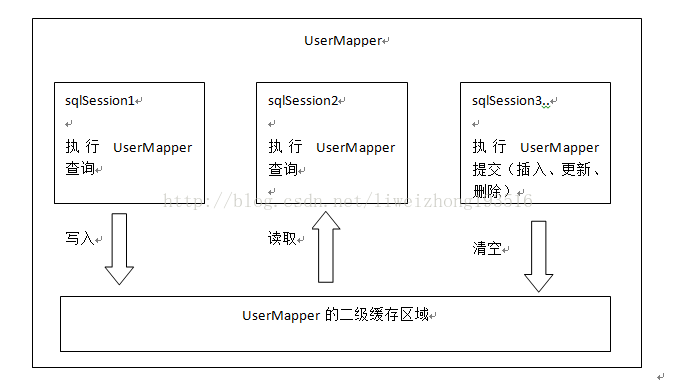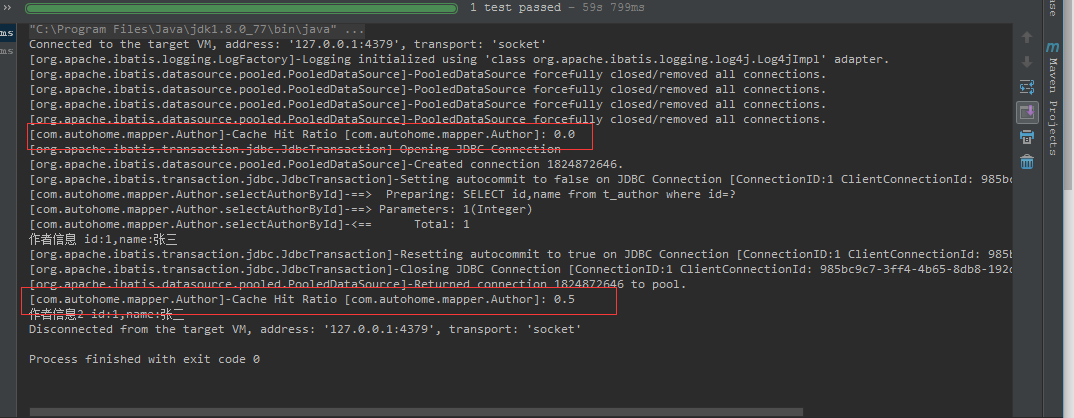前言
使用ORM框架我们更多的是使用其查询功能,那么查询海量数据则又离不开性能,那么这篇中我们就看下mybatis高级应用之延迟加载、一级缓存、二级缓存。使用时需要注意延迟加载必须使用resultMap,resultType不具有延迟加载功能。
一、延迟加载
延迟加载已经是老生常谈的问题,什么最大化利用数据库性能之类之类的,也懒的列举了,总是我一提到延迟加载脑子里就会想起来了Hibernate get和load的区别。OK,废话少说,直接看代码。 先来修改配置项xml。
注意,编写mybatis.xml时需要注意配置节点的先后顺序,settings在最前面,否则会报错。
<settings> <setting name="lazyLoadingEnabled" value="true"/> <setting name="aggressiveLazyLoading" value="false"/> </settings>

前面提到延迟加载只能通过association、collection来实现,因为只有存在关联关系映射的业务场景里你才需要延迟加载,也叫懒加载,也就是常说的用的时候再去加载。OK,那么我们来配一个association来实现:
我来编写一个加载博客列表的同时加载出博客额作者, 主要功能点在id为blogAuthorResumtMap这个resultmap上,其中使用了association,关键点是它的select属性,该属性也就是你需要懒加载调用的statment id。 当然需要懒加载的statement 返回值当然是resultmap
<resultMap id="blogAuthorResumtMap" type="Blog"> <id column="id" property="id"/> <result column="title" property="title"/> <result column="category" property="category"/> <result column="author_id" property="author_id"/> <!--使用assocition支持延迟加载功能,配置延迟加载关联关系--> <association property="author" javaType="Author" select="selectAuthorById" column="author_id"/> </resultMap> <!--要使用延迟记载的方法--> <select id="selectBlogAuthor" resultMap="blogAuthorResumtMap"> SELECT id,title,category,author_id FROM t_blog </select> <!--延迟加载查询博客对应的作者方法--> <select id="selectAuthorById" parameterType="int" resultType="Author"> SELECT id,name from t_author where id=#{value} </select>
OK,来看测试结果:
@Test
public void getBlogAuthorByLazyloading(){
SqlSession sqlSession=null;
try{
sqlSession=sqlSessionFactory.openSession();
List<Blog> list = sqlSession.selectList("com.autohome.mapper.Author.selectBlogAuthor");
for (Blog blog:list) {
System.out.println("id:"+blog.getId()+",title:"+blog.getTitle()+",category:"+blog.getCategory());
System.out.println("author:"+blog.getAuthor().getName());
}
}catch(Exception e){
e.printStackTrace();
}finally {
sqlSession.close();
}
}


从图一中看出,执行selectBlogAuthor返回List<Blog>对象时只执行了SQL SELECT id,title,category,author_id from t_blog,循环遍历时才去执行select id,name from t_author where id=?。
二、一级缓存
了解缓存前我们先看一张图片(图片来源于传智播客视频图片)。从图中可以了解一级缓存是sqlsession级别、二级缓存是mapper级别。在操作数据库时我们需要先构造sqlsession【默认实现是DefaultSqlSession.java】,在对象中有一个数据结构【hashmap】来存储缓存数据。不同的sqlsession区域是互不影响的。 如果同一个sqlsession之间,如果多次查询之间执行了commit,则缓存失效,mybatis避免脏读。

OK,在看mybatis一级缓存时,我总是觉的一级缓存有点鸡肋,两个查询如果得到一样的数据,你还会执行第二次么,果断引用第一次的返回值了。 可能还没了解到一级缓存的奥妙之处。一级缓存默认是开启的,不需要额外设置,直接使用。
public void testCache(){
SqlSession sqlSession=null;
try{
sqlSession=sqlSessionFactory.openSession();
Author author = sqlSession.selectOne("com.autohome.mapper.Author.selectAuthorById",1);
System.out.println("作者信息 id:"+author.getId()+",name:"+author.getName());
author = sqlSession.selectOne("com.autohome.mapper.Author.selectAuthorById",1);
System.out.println("作者信息2 id:"+author.getId()+",name:"+author.getName());
}catch(Exception e){
e.printStackTrace();
}finally {
sqlSession.close();
}
}

从DEBUG截图来看,当我们第一次调用方法时执行了SELECT id,name from t_author where id=? 此时缓存中还没有该数据,则执行数据库查询,当再次执行时直接从缓存中读取。
执行demo后我们来看下这个查询过程保存到缓存的源码,先看下DefaultSqlSession.java。我们调用的selectOne(),从代码中看它是直接调用selectList()然后判断返回值size大小。
@Override
public <T> T selectOne(String statement) {
return this.<T>selectOne(statement, null);
}
@Override
public <T> T selectOne(String statement, Object parameter) {
// Popular vote was to return null on 0 results and throw exception on too many.
List<T> list = this.<T>selectList(statement, parameter);
if (list.size() == 1) {
return list.get(0);
} else if (list.size() > 1) {
throw new TooManyResultsException("Expected one result (or null) to be returned by selectOne(), but found: " + list.size());
} else {
return null;
}
}
再跟踪到selectList方法,看到先构造MappedStatement对象,然后看到真正执行query()的是一个executor对象,在DefaultSqlSession.java中executor是成员变量,再翻到org.apache.ibatis.executor包中看到executor实际是一个接口。OK,那么我们debug时发现其引用是CachingExecutor。再打开CachingExecutor.java
@Override
public <E> List<E> selectList(String statement, Object parameter, RowBounds rowBounds) {
try {
MappedStatement ms = configuration.getMappedStatement(statement);
return executor.query(ms, wrapCollection(parameter), rowBounds, Executor.NO_RESULT_HANDLER);
} catch (Exception e) {
throw ExceptionFactory.wrapException("Error querying database. Cause: " + e, e);
} finally {
ErrorContext.instance().reset();
}
}
从CachingExecutor.java的两个query()可以看到先去构造CacheKey 再调用抽象类BaseExecutor.query(),这个也是最关键的一步。
//先创建CacheKey
public <E> List<E> query(MappedStatement ms, Object parameterObject, RowBounds rowBounds, ResultHandler resultHandler) throws SQLException {
BoundSql boundSql = ms.getBoundSql(parameterObject);
CacheKey key = createCacheKey(ms, parameterObject, rowBounds, boundSql);
return query(ms, parameterObject, rowBounds, resultHandler, key, boundSql);
}
//再执行查询方法
public <E> List<E> query(MappedStatement ms, Object parameterObject, RowBounds rowBounds, ResultHandler resultHandler, CacheKey key, BoundSql boundSql)
throws SQLException {
Cache cache = ms.getCache();
if (cache != null) {
flushCacheIfRequired(ms);
if (ms.isUseCache() && resultHandler == null) {
ensureNoOutParams(ms, parameterObject, boundSql);
@SuppressWarnings("unchecked")
List<E> list = (List<E>) tcm.getObject(cache, key);
if (list == null) {
list = delegate.<E> query(ms, parameterObject, rowBounds, resultHandler, key, boundSql);
tcm.putObject(cache, key, list); // issue #578 and #116
}
return list;
}
}
return delegate.<E> query(ms, parameterObject, rowBounds, resultHandler, key, boundSql);
}
BaseExecutor.java
public <E> List<E> query(MappedStatement ms, Object parameter, RowBounds rowBounds, ResultHandler resultHandler, CacheKey key, BoundSql boundSql) throws SQLException {
ErrorContext.instance().resource(ms.getResource()).activity("executing a query").object(ms.getId());
if (closed) {
throw new ExecutorException("Executor was closed.");
}
if (queryStack == 0 && ms.isFlushCacheRequired()) {
clearLocalCache();
}
List<E> list;
try {
queryStack++;
list = resultHandler == null ? (List<E>) localCache.getObject(key) : null;
if (list != null) {
handleLocallyCachedOutputParameters(ms, key, parameter, boundSql);
} else {
list = queryFromDatabase(ms, parameter, rowBounds, resultHandler, key, boundSql);
}
} finally {
queryStack--;
}
if (queryStack == 0) {
for (DeferredLoad deferredLoad : deferredLoads) {
deferredLoad.load();
}
// issue #601
deferredLoads.clear();
if (configuration.getLocalCacheScope() == LocalCacheScope.STATEMENT) {
// issue #482
clearLocalCache();
}
}
return list;
}
再看其中关键代码queryFromDatabase
private <E> List<E> queryFromDatabase(MappedStatement ms, Object parameter, RowBounds rowBounds, ResultHandler resultHandler, CacheKey key, BoundSql boundSql) throws SQLException {
List<E> list;
localCache.putObject(key, EXECUTION_PLACEHOLDER);
try {
list = doQuery(ms, parameter, rowBounds, resultHandler, boundSql);
} finally {
localCache.removeObject(key);
}
localCache.putObject(key, list);
if (ms.getStatementType() == StatementType.CALLABLE) {
localOutputParameterCache.putObject(key, parameter);
}
return list;
}
OK,看了一长串,终于是有点眉目了,我们看到finally中先删除当前key缓存,然后再调用localCache.putObject把最新的结果集存入HashMap中。
三、二级缓存
了解二级缓存之前先来看副图(图片来自传智播客视频,非本人编写),那么从图中我们可以看出,mybatis二级缓存是mapper级别,也就是说不同的sqlmapper共享不同的内存区域,不同的sqlsession共享同一个内存区域,用mapper的namespace区别内存区域。

开启mybatis二级缓存: 1、设置mybatis.xml,也就是说mybatis默认二级缓存是关闭的。
2、设置mapper。在mapper.xml内添加标签:<cache/>
3、pojo实现接口Serializable。实现该接口后也就说明二级缓存不仅可以存入内存中,还可以存入磁盘。
OK,看一个二级缓存demo:
@Test
public void testCache2(){
SqlSession sqlSession=null;
SqlSession sqlSession2=null;
try{
sqlSession=sqlSessionFactory.openSession();
sqlSession2=sqlSessionFactory.openSession();
Author author = sqlSession.selectOne("com.autohome.mapper.Author.selectAuthorById",1);
System.out.println("作者信息 id:"+author.getId()+",name:"+author.getName());
sqlSession.close();
Author author2 = sqlSession2.selectOne("com.autohome.mapper.Author.selectAuthorById",1);
System.out.println("作者信息2 id:"+author2.getId()+",name:"+author2.getName());
sqlSession2.close();
}catch(Exception e){
e.printStackTrace();
}finally {
}
}
运行demo可以看出二级缓存不同的地方在于Cache Hit Ratio,发出sql查询时先看是否命中缓存,第一次则是0.0 ,再次查询时则直接读取缓存数据,命中率是0.5。当然数据结构还是HashMap。
如果数据实时性要求比较高,可以设置select 语句的

如果数据的查询实时性要求比较高,则设置select语句的useCache="false",则每次都直接执行sql。
<select id="selectBlogAuthor" resultMap="blogAuthorResumtMap" useCache="false">
SELECT id,title,category,author_id FROM t_blog
</select>